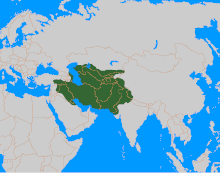Tamerlanes
Tamerlanes[1][2] (Tschagataice تيمور Temür 'ferrum'; natus 9 Aprilis 1336; mortuus 17–19 Februarii 1405), postea Timūr Gurkānī (Tschagataice تيمور کورگن Temür Küregen[3]), nomine aliquando Taimur scripto, in historia plerumque Amir Timur appellatus (Persice تيمور لنگ Temūr(-i) Lang; Tschagataice اقساق تیمور Aqsaq Temür,[4]; Anglice Tamerlane 'Temür Claudus'), fuit conquestor Turco-Mongolicus, qui Imperium Timuridarum in et circa Afganiam, Iraniam, et Asiam Mediam condidit, primus domus Timuridarum rector. Imperator invictus late putatur unus e maximis mundi ducibus exercituum et rei militaris peritis.[5][6] Etiam habetur magnus artis architecturaeque patronus, qui Ibn Khaldun, Hafiz-i Abru, aliisque hominibus magnae mentis de facie utebatur, atque eius regnum Renascentiam Timuridarum introduxit.[5]


Nexus interni
Nota recensere
- ↑ Ei sunt multa nomina secundum sermones, exempli gratia, Tīmür bin Taraghay Barlas, Temur, Taimur, Timur Lenk, Timur-i Leng, Temur -e Lang, Amir Timur, Aqsaq Timur, Tamerlano, et Tamburlaine.
- ↑ Attestatio Latini nominis: De Tamerlanis Parthi rebus gestis. Ibidem etiam: Tamerlanus. Alia nomina Latina: Timurus ([1]), Temurlenus ([2]), Tamburlanus ([3]).
- ↑ Heissig, Walther; Sagaster, Klaus (1989). Gedanke und Wirkung: Festschrift zum 90. Geburtstag von Nikolaus Poppe. ISBN 9783447028936.
- ↑ Johanson, Lars (1998). The Turkic Languages. Routledge. p. 27. ISBN 0-415-08200-5.
- ↑ 5.0 5.1 Marozzi, Justin (2004). Tamerlane: Sword of Islam, conqueror of the world. HarperCollins.
- ↑ Josef W. Meri (2005). Medieval Islamic Civilization. Routledge. p. 812. ISBN 9780415966900.
Bibliographia recensere
- Knobler, Adam. 1995. "The Rise of Tīmūr and Western Diplomatic Response, 1390–1405." Journal of the Royal Asiatic Society Third Series 5 (3): 341–49. doi:10.1017/S135618630000660X.
- Knobler, Adam. 2001. "Timur the (Terrible/Tartar) Trope: a Case of Repositioning in Popular Literature and History." Medieval Encounters 7 (1): 101–112. doi:10.1163/157006701X00102.
- Manz, Beatrice Forbes. 1999. The Rise and Rule of Tamerlane. Cantabrigiae: Cambridge University Press. ISBN 9780521633840.
- May, Timothy. "Timur ("the Lame") (1336–1405)." The Encyclopedia of War.
- Melville, Charles. 2020. The Timurid Century: The Idea of Iran. Vol. 9. University of Cambridge. Bloomsbury Publishing. ISBN 9781838606152.
- Nicol, Donald M. 1993. The Last Centuries of Byzantium, 1261–1453. Cantabrigiae: Cambridge University Press. ISBN 9780521439916.
- Tsai, Shih-Shan Henry. 2002. Perpetual Happiness: The Ming Emperor Yongle. Seattli: University of Washington Press. ISBN 9780295981246. OCLC 870409962.
Nexus externi recensere
| Vicimedia Communia plura habent quae ad Tamerlanem spectant. |
| Lexica biographica: • Большая российская энциклопедия • Gran Enciclopèdia Catalana • Deutsche Biographie • Store norske leksikon |